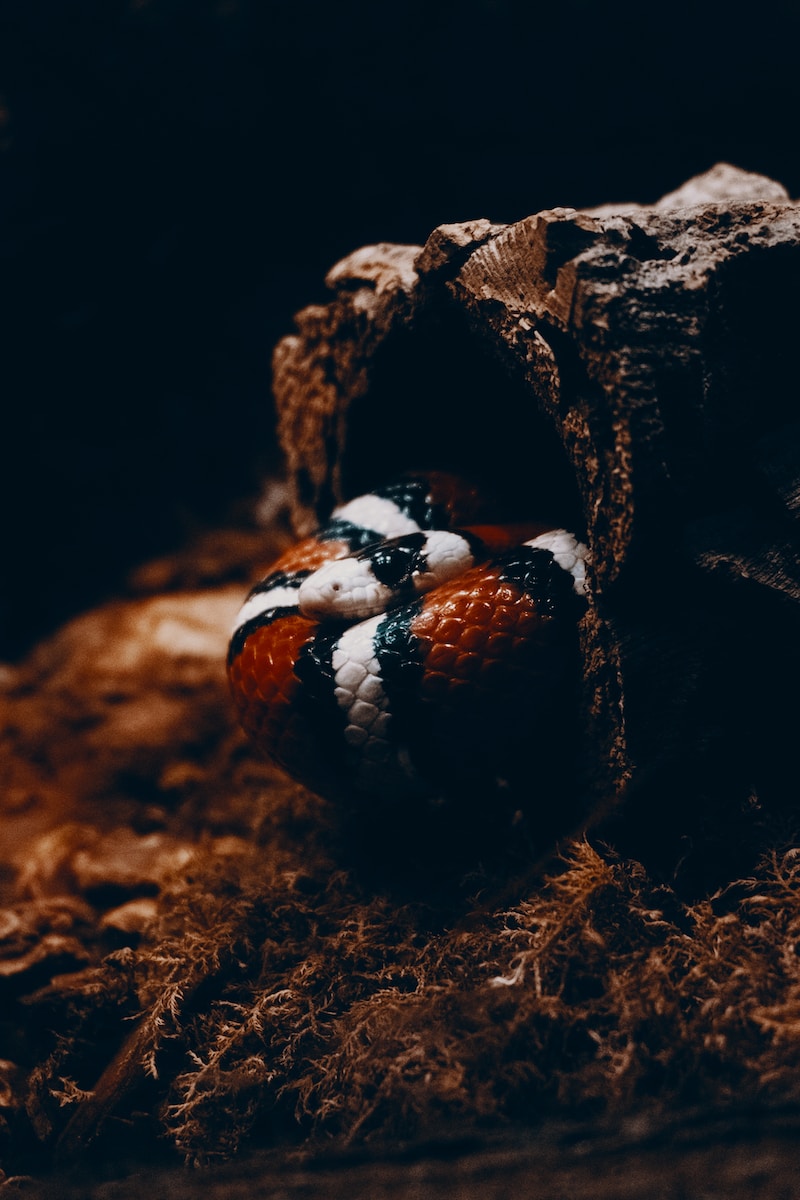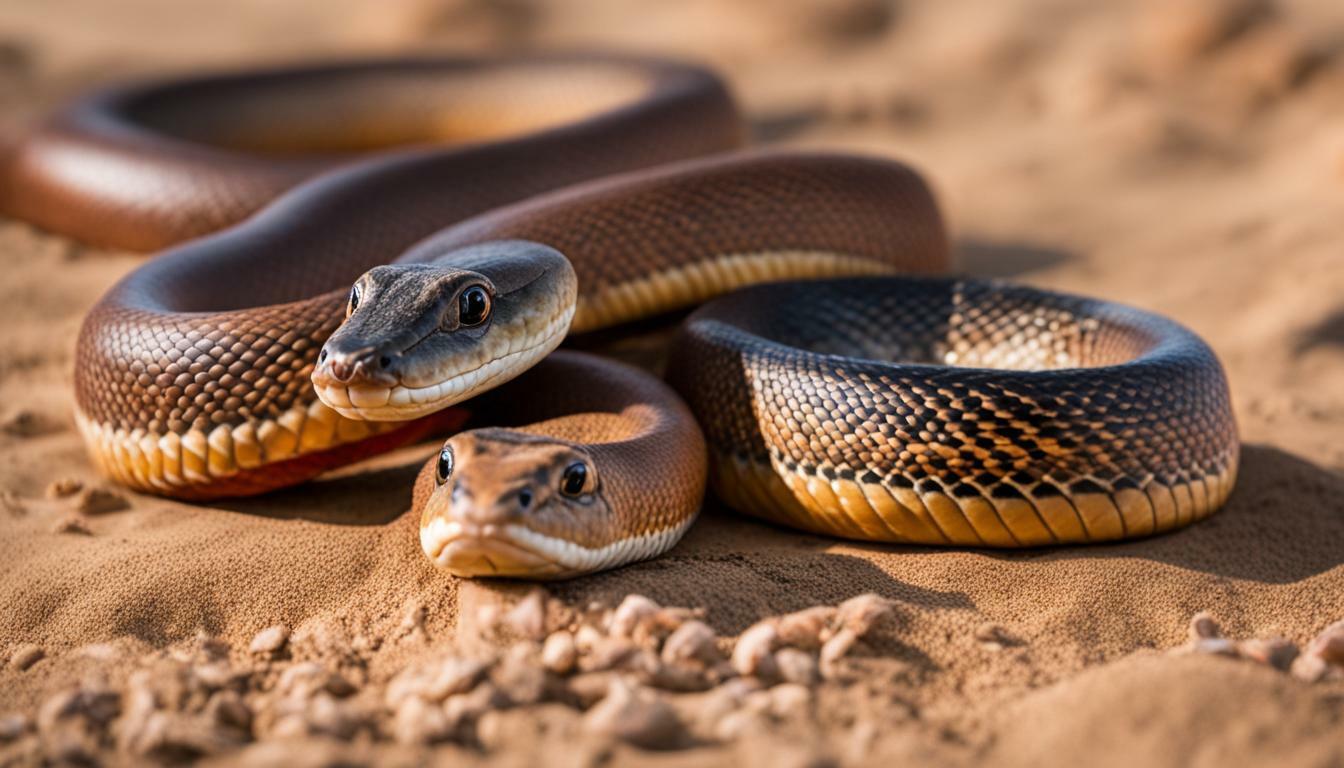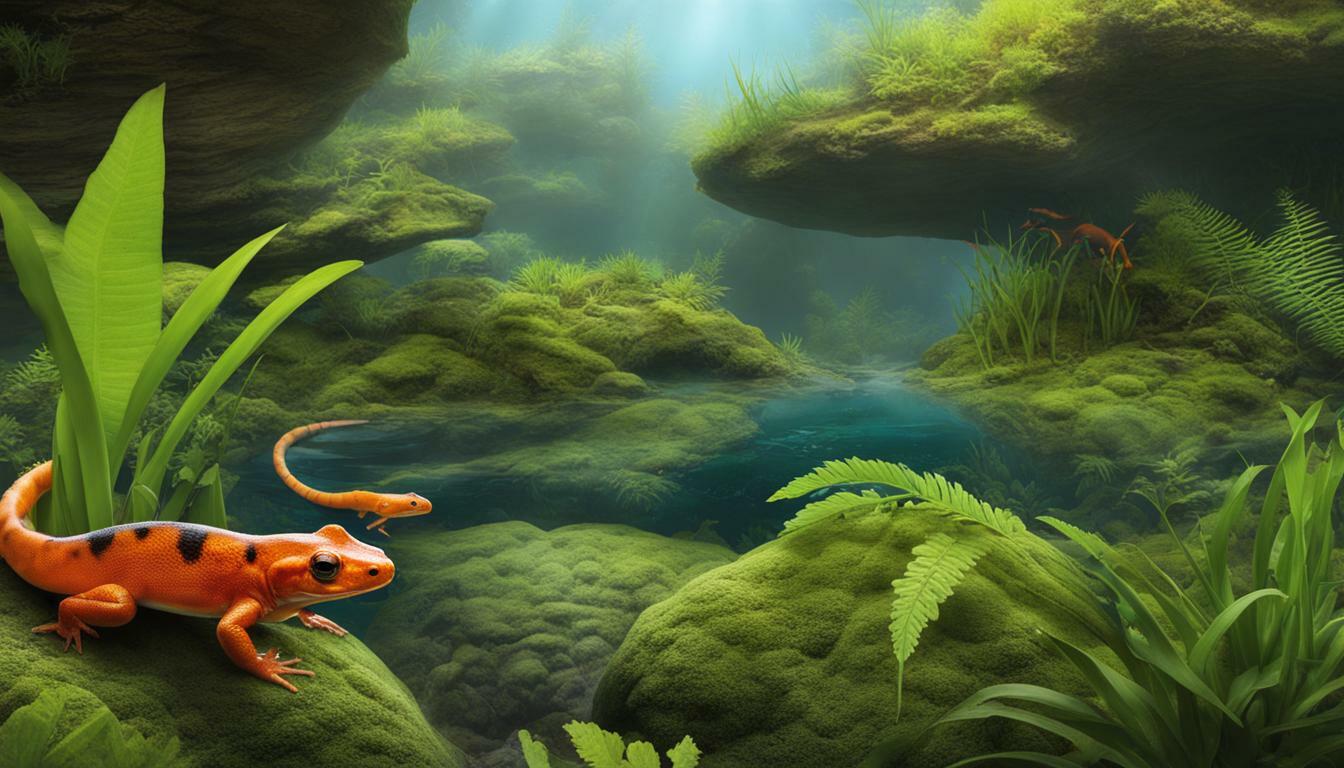Introduction: A Tale of Two Serpents
In the wondrous world of wildlife, peculiar pairings often perplex even the most seasoned herpetologists. Our tale is one such story, where two slithering creatures share enough similarities to make distinguishing them a tricky task for the untrained eye. Dive with us into this intriguing narrative as we unravel the curious case of mistaken identity between Milk Snakes and Coral Snakes.
Not All That Glitters is Venomous: The Enigmatic Duo’s Deception
To an unwary observer, a Milk Snake and a Coral Snake might seem virtually indistinguishable. Both these serpents sport similar vibrant color patterns – resplendent bands of red, black, and yellow streaked along their bodies. It’s Mother Nature’s own version of artful mimicry.
But why such near-identical appearances for two vastly different species? The answer lies in their survival strategies.
Milk Snakes, benign and non-venomous as they are, have evolved to imitate their venomous doppelgangers – the Coral Snakes – in coloration as a foolproof method to ward off potential predators. You see, nothing screams ‘stay away’ better than being mistaken for one of the most venomous snakes in North America.
Quick snapshot: Basic facts about Milk and Coral Snakes
Before we delve deeper into our exploration, let’s familiarize ourselves with some fundamental facts about these two fascinating species that will further illuminate their inherent differences despite shared aesthetic characteristics.
Milk Snake Musings: Beneath The Colorful Exterior
The Milk Snake (Lampropeltis triangulum), is a member of the king snake family known for its distinct tricolor pattern reminiscent of its venomous counterpart – the coral snake. They are found across North America, spanning from Canada to Central America.
Although their size can vary depending on the specific subspecies, most Milk Snakes reach a length of about 2 to 3 feet. They are nocturnal creatures by nature, and you’ll usually find them hiding under rocks or logs during the day.
Coral Snake Chronicles: More Than Meets The Eye
Coral Snakes (Micrurus fulvius), on the other hand, belong to the Elapidae family and are closely related to cobras. They dwell predominantly in the southeastern parts of North America and have a more elongated body compared to Milk Snakes that typically measures between 2 and 5 feet in length. Coral snakes are hands-down one of the most venomous snakes in North America and owe their name to their vividly colored bodies – red, yellow, and black bands – which hint at their potent venomous capabilities.
Meet the Milk Snake: Unraveling the Mystery
In the fascinating world of serpents, the Milk Snake (Lampropeltis triangulum) holds a distinctive place. No, they don’t produce or drink milk – a folk tale that led to their intriguing name.
Instead, these medium-sized creatures belong to the larger family of kingsnakes and are renowned for their vibrant color patterns that mimic some deadly counterparts. Contrary to common misconceptions, this non-venomous constrictor is more friend than foe.
They’re typically good-natured and prefer flight over fight when confronted with danger. Don’t let their quiet demeanor fool you though – these intelligent reptiles are quite adept at hunting and securing their prey.
A Journey Through Habitats: Home Sweet Home
Milk Snakes are truly cosmopolitan in nature – you can find them across North America from Canada all through to South America. Their adaptability is remarkable as they can survive in diverse environments ranging from forests and fields to rocky outcrops and even suburban backyards.
Their choice of home base is largely driven by food supply and availability of safe places to lay eggs. And while they do have a predilection for secretive hideouts such as under rocks or logs during daylight hours, don’t be surprised if you come across one during your nighttime adventures!
Fashion sense in the Reptile World: Decoding Patterns & Colors
Standing out in style is an art that Milk Snakes have mastered beautifully! Their bodies boast contrasting bands of red or orange interspersed with black and white/yellow rings – a striking ensemble indeed!
This captivating pattern serves not just aesthetic purposes but also plays a significant role in their survival strategy. Mimicry is the name of the game here.
The resemblance to the venomous Coral Snake acts as a defensive mechanism, confusing predators and allowing our Milk Snake hero to escape unscathed. However, this camouflage isn’t foolproof and discerning eyes can pick out differences – remember the saying, “Red touches yellow, kills a fellow. Red touches black, venom lack?” That’s your clue right there!
Behind the Vibrant Colors: Say Hello to Coral Snakes
More Than Just a Pretty Face: Getting Acquainted with Coral Snakes
Meet the Coral snake, a brilliantly colored creature that’s as much a visual delight as it is an emblem of danger in the wild. Belonging to the Elapidae family, this snake makes a lasting impression with its bright bands of red, yellow, and black.
But don’t let its striking beauty fool you. This serpentine member is one of North America’s most venomous snakes, whose bite can be fatal if left untreated.
While their vibrant colors might suggest otherwise, coral snakes are quite shy creatures and prefer to stay hidden away from human sight. They utilize their resplendent coloration not for show but as a cautionary message to potential predators – an effective strategy that screams ‘stay away’ in nature’s universal language.
A Walk on the Wild Side: Tracing the Habitat of Coral Snakes
Where Beauty Resides: Deciphering The Habitat Choices Of Coral Snakes
Coral snakes have quite diverse housing preferences ranging from flat coastal plains to rocky hillsides. These elusive creatures are predominantly found in the southern and western regions of the United States especially in states like Arizona and Florida. They appreciate areas heavily laden with leaf litter or loose soil which enable them to burrow and stay hidden.
As much as they love terrestrial life, some coral snake species have taken a liking for aquatic habitats too. You’ll find them around marshy areas or near bodies of water such as streams or ponds where they thrive amidst dense vegetation offering good cover.
A Closer Look at Their Rainbow Attire: Understanding The Patterns And Hues Of Coral Snakes
Decoding Nature’s Palette: Interpreting The Distinctive Colors Of Coral Snakes
A closer inspection unravels a world of details in their vibrant patterns. Coral snakes sport alternating bands of red, yellow (or white), and black. The rule of thumb that helps distinguish them from harmless mimics goes as follows: “Red on yellow, kill a fellow; red on black, venom lack.” This refers to the color arrangement – In true coral snakes, the red band is always bordered by the yellow or white one.
However, it’s essential to remember that color patterns can vary across species and geographical regions. It’s also important to note that some non-venomous species such as milk snakes bear resemblance to coral snakes with similar banding patterns – a nature’s ruse designed for survival which often leads to mistaken identities.
Doppelgangers or Distinct? – Comparing Physical Characteristics
Size Matters, Or Does It? Comparing Lengths and Girths
When it comes to Milk Snakes and Coral Snakes, size is indeed one of the vital aspects that defines their very essence. Milk snakes, being part of the larger kingsnake family, tend to display a considerable variation in size. These intriguing creatures can range anywhere from 14 inches as hatchlings to an impressive 5 feet in adult specimens. However, the majority hover around a modest 2-3 feet in length. On the flip side of the coin are Coral Snakes. They’re often slightly smaller compared to their milky counterparts – typically averaging between 18 inches and 3 feet. However, some species such as Micrurus fulvius (Eastern coral snake) can reach up to 5 feet – matching up with the maximum length seen in milk snakes.
Color Chaos – Breaking Down Their Similar Yet Distinct Color Patterns
If there were ever an instance where color could be misleading yet informative at the same time, it would be whilst examining Milk Snakes and Coral Snakes. At first glance, both feature a vibrant palette of red, black and yellow bands. This striking similarity is actually an example of Batesian mimicry – where harmless species imitate harmful ones for survival benefits.
However upon closer inspection, you’d notice a key difference lying in their band sequence; most North American coral snakes follow the “red touch yellow” pattern whereas milk snakes abide by “red touch black”. Remembering this simple rhymic rule “Red touch yellow – kill a fellow; red touch black – venom lack”, can assist greatly not just in identification but also in ensuring your safety during any potential encounters.
Head Shape and Eye Size – Small Details that Make a Big Difference
The details are not in the devil, but rather, in the head of these serpents. Milk Snakes possess a relatively round head that is barely distinguishable from the body. Their eyes, with round pupils, lend them an innocent and non-threatening appearance.
Coral Snakes wear a more sinister look with a black-colored head acting as their intimidating mask. This is often contrasted by a bright yellow ring that borders the neck region.
Furthermore, their eyes tend to be relatively smaller – adding an extra hint of mystery to their overall persona. And it’s this very detail—this miniscule yet crucial aspect—that helps discern these fascinating creatures from one another.
Behavior Patterns: More Than Just Skin Deep
Social Dispositions: Solitary Serpents or Gregarious Gatherers?
Unfolding the social behavior of these two distinctive serpents, one might be surprised by their asocial tendencies. Milk snakes, despite their non-venomous nature and harmless demeanor, predominantly portray a solitary lifestyle.
They are loners in the truest sense; whether while hunting for a meal or simply lounging in their natural habitats. They interact with others of their kind only during the breeding season, showcasing an interesting paradox – being seemingly benign yet unsociable.
Likewise, Coral snakes mirror this individualistic trait. Bearing the title of one of North America’s most venomous snakes doesn’t make them party animals, quite ironically.
Their interactions with other creatures are minimal and usually defensive in nature rather than social. Intriguingly enough, these colorful serpents prefer to lead reclusive lives away from all the hustle-bustle – painting an intriguing picture of isolation amidst vibrancy.
Activity Cycles: Diurnal Dwellers or Nocturnal Nomads?
Understanding the activity patterns of our scaly friends provides another layer to their complex personas. Take Milk snakes for example – they are primarily nocturnal creatures who choose to venture out after sundown when temperatures are more tolerable and chances of predation relatively lower.
Coral Snakes on contrary tend to be diurnal, especially in cooler weather, making them active during daylight hours when temperatures are ideal for them to hunt and explore. However, it’s worth noting that in regions with hotter climates these brightly-colored reptiles display crepuscular behavior – becoming active at dawn and dusk – perfectly exemplifying nature’s flexible timetable based on survival instincts.
Foods On Their Plate: What Do These Serpents Sup On?
The culinary preferences of these reptiles offer another interesting dimension to their characters. Milk snakes are known for their varied palate, feasting on a diet that includes but is not limited to rodents, eggs, birds, and even other reptiles – embodying the true spirit of an opportunistic eater.
Conversely, Coral Snakes have a more specialized dietary preference. They predominantly prey on other smaller snakes and occasionally branch out to lizards or small rodents.
The venomous bite of the Coral Snake proves lethal for its prey, immobilizing it almost instantly. This ‘bite-and-hold’ technique distinguishes it from constrictors like their Milk snake counterparts who prefer to coil around their prey – capturing the diverse survival strategies in these closely compared yet starkly different serpents.
A Bite to Remember: The Consequences of Misfortune
Snake bites are no laughing matter, and the distinction between a venomous coral snake bite and a non-venomous milk snake nip is paramount. A bite from a coral snake can be life-threatening, given its highly potent venom.
Despite their reserved demeanor, when agitated, these serpents will not hesitate to defend themselves. On the other hand, a milk snake’s bite poses no lethal threat; discomfort and slight swelling may occur but nothing as grave as its colorful mimic.
Despite seeming benign in comparison to coral snakes, it is crucial not to underestimate milk snakes’ ability to inflict pain through their bites. Although they lack venom glands and teeth designed for envenomation like vipers do, their small sharp teeth can still cause a reasonable amount of discomfort especially if mishandled or startled.
The Fire Within: Venom Potency in Coral Snakes
The potency of the coral snake’s venom is something out of nature’s magnificent yet terrifying toolbox; it cannot be understated. Even though they are less likely to bite compared to other venomous snakes (due to their elusive nature), untreated bites from these creatures often lead to serious medical conditions or even death.
The neurotoxic properties in their venom affect nervous tissue leading paralysis and respiratory failure. Interestingly enough, despite the formidable power behind each drop of coral snake’s venom, these species aren’t considered as threatening as one might expect because they deliver less venom than other types due in part to their less effective delivering mechanism – small fixed fangs at front of the mouth rather than long folding fangs like vipers.
Respect Thy Neighbor: Living Safely with Milk Snakes
Milk snakes are everywhere—in our gardens, parks and sometimes they make the odd house call when we leave our doors open. They are generally harmless and indeed beneficial creatures, keeping the population of pests such as rats and mice under control. Respecting these creatures, understanding their behavior, and giving them space can go a long way in avoiding any unwanted confrontations, bites included.
Remember, these snakes are more afraid of you than you are of them–so if you spot a milk snake (or any snake for that matter), it’s best to let it be. While milk snakes’ bites won’t land you in a hospital bed fighting for your life like coral snakes’, they can still cause discomfort and distress to both parties involved.
Conclusion
While coral snakes and milk snakes might share strikingly similar wardrobes, the differences between them certainly run skin deep. Understanding their unique characteristics not only helps us appreciate nature’s wonderful diversity but also instills respect for these magnificent creatures. As we continue to share our world with them, living harmoniously remains a mutual goal – ensuring their survival while maintaining our safety.



